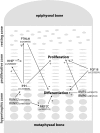Synthesizing genome-wide association studies and expression microarray reveals novel genes that act in the human growth plate to modulate height
- PMID: 22914739
- PMCID: PMC3490510
- DOI: 10.1093/hmg/dds347
Synthesizing genome-wide association studies and expression microarray reveals novel genes that act in the human growth plate to modulate height
Abstract
Previous meta-analysis of genome-wide association (GWA) studies has identified 180 loci that influence adult height. However, each GWA locus typically comprises a set of contiguous genes, only one of which presumably modulates height. We reasoned that many of the causative genes within these loci influence height because they are expressed in and function in the growth plate, a cartilaginous structure that causes bone elongation and thus determines stature. Therefore, we used expression microarray studies of mouse and rat growth plate, human disease databases and a mouse knockout phenotype database to identify genes within the GWAS loci that are likely required for normal growth plate function. Each of these approaches identified significantly more genes within the GWA height loci than at random genomic locations (P < 0.0001 each), supporting the validity of the approach. The combined analysis strongly implicates 78 genes in growth plate function, including multiple genes that participate in PTHrP-IHH, BMP and CNP signaling, and many genes that have not previously been implicated in the growth plate. Thus, this analysis reveals a large number of novel genes that regulate human growth plate chondrogenesis and thereby contribute to the normal variations in human adult height. The analytic approach developed for this study may be applied to GWA studies for other common polygenic traits and diseases, thus providing a new general strategy to identify causative genes within GWA loci and to translate genetic associations into mechanistic biological insights.
Figures



References
-
- Kronenberg H.M. Developmental regulation of the growth plate. Nature. 2003;423:332–336. - PubMed
-
- Nilsson O., Baron J. Fundamental limits on longitudinal bone growth: growth plate senescence and epiphyseal fusion. Trends Endocrinol. Metab. 2004;15:370–374. - PubMed
-
- van der Eerden B.C., Karperien M., Wit J.M. Systemic and local regulation of the growth plate. Endocr. Rev. 2003;24:782–801. - PubMed
-
- Wuelling M., Vortkamp A. Transcriptional networks controlling chondrocyte proliferation and differentiation during endochondral ossification. Pediatr. Nephrol. 2010;25:625–631. - PubMed
Publication types
MeSH terms
Grants and funding
LinkOut - more resources
Full Text Sources
Other Literature Sources
Research Materials

